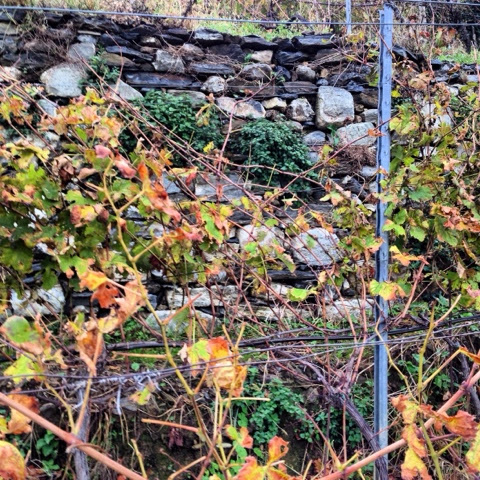 |
| Rainbow over the hills of Vernazza |
We live in a national park and a UNESCO world heritage site, and an incredibly fragile one at that. As one of our guest speakers noted, the Cinque Terre is one of the few national parks that relies on man to keep it alive. Whereas other parks are simply nature, untouched, at its pure finest, the Cinque Terre relies on the terracing systems of the vineyards that stretch on the hills between the villages. Manmakes these terraces, so it's a very delicate, very beautiful, and very important balance between man working with nature rather than against it.
One of the main points we've discussed is the importance of sourcing products at "kilometer 0", or, in other words, eating local. As local as you can get. All of this eating local is integral to creating and promoting sustainable and responsible tourism, but you need to wash it down with something.
One cannot come here and avoid wine. Even if it's not in a glass in front of you, it's neatly covering the hills sloping down into the villages, in even little rows held up by ancient stone walls. These wine terraces, they say, if put back to back, are as long as the Great Wall of China. That's pretty long. And they don't make wine on the Great Wall, so I'd say we win.
Without going into too much wine detail, as I'm not a sommelier and don't pretend to be, the wine here is mostly white, and has to be a blend of grapes including Bosco, Vermentino and Albarola. It's on the drier side, and was never, in all honesty, to my taste until this year. Manuel's mom explained once that you can certainly find more prestigious white wines in Italy, more award winners, but you will never find a wine that is made with these centuries of hard, back breaking work carrying the grapes up and down these terraces mountains that loom over us. There is a great story and a great determination in these wines and the Ligurians who have been making them for centuries.
After pondering this, the next glass I drank took on a new meaning. Even more so when I realized that the land depends on these terraces to keep it stable. The great majority of villagers are no longer relying on farming and fishing to make a living, the many small, usually family run wine producers in the region are doing more then providing us with something to drink- they are helping keep that delicate, crucial balance between man and nature.
Today we hiked up small, slippery stone steps to the vineyards of Cheo, a small producer in Vernazza that was all but destroyed in the flood. The husband and wife team were able to rebuild, with help from other wine producers in the region who came right over and helped them the laborious work of reconstructing the dry stone walls that create the terraces that compose the vineyards on the mountains. They are incredibly lovely people, which is even nicer to know, as their wine is one of my favorites in the Cinque Terre. The grapes that grow in the summer sun over the Ligurian sea, with the colorful little village of Vernazza spread out before them, make a beautiful picture. Descending the narrow steps back to the village, however, you are again reminded that what makes a surreal postcard is also an incredibly labor intensive work.
Tourists visiting the region can do their part quite easily. Drink up! The majority of the wines here are small producers, and it's critical to the sustainability of the region that their production continues (here in Monterosso, Vetua and Begasti are my favorites, outside, Cheo from Vernazza, La Polenza and Forlini Cappellini are other great ones...). Little did you know that drinking some local wines, watching the colors of orange and pink, as the sun kisses the still blue sea, you were perfectly doing your
part to help ensure the future of our amazing National Park.






Christine;
ReplyDeleteSorry that we didn't get to spend some time with you on our last trip to Monterosso, but maybe that was because of my doing my part of helping to keep the soils stable by drinking many glasses of wine at a time.
Bob
HA! I was too busy serving them, so no worries! Next time :)
ReplyDeleteVery nice way to put the attention on sustainable tourism and the delicate terracing system. Local products should be part of any trip around Italy! But what about places (stores, importers or online sites) where we might be able to buy the wines and thus contribute to the cause?
ReplyDelete